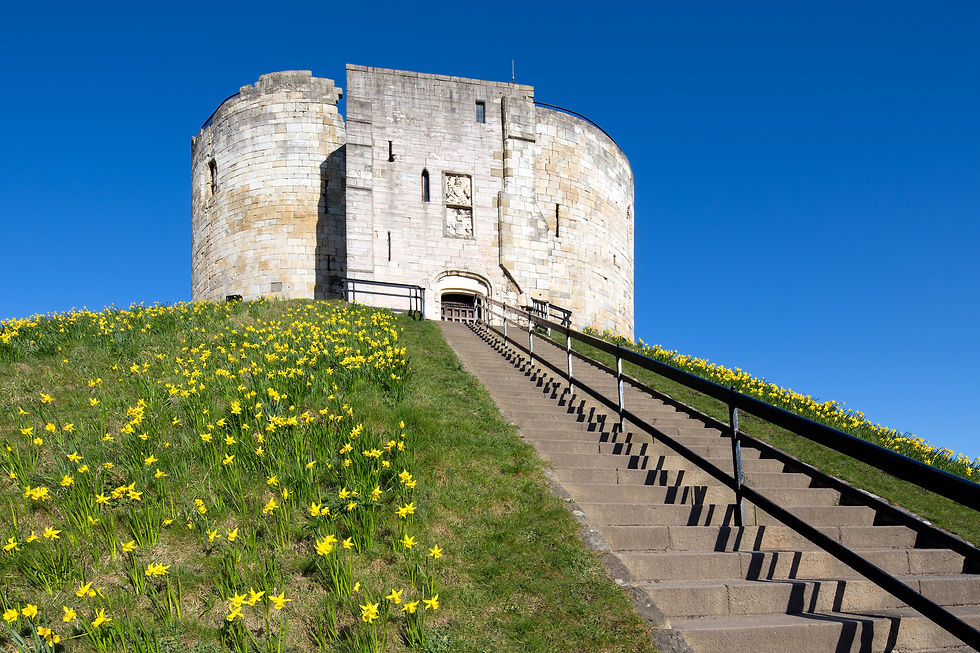A Brief history of Clifford's Tower in York
- timbarber
- Feb 7
- 3 min read

To think that something once known scornfully by York residents as the “mince pie” has served as a seat of royal government and the administrative focus of the whole of Yorkshire.
We are talking about Clifford’s Tower, which has played a major part in the history of York for nearly a thousand years. It was originally built by William the Conqueror in 1068 two years after the Norman Conquest.
It is what is known as a motte & bailey castle – a type of defence used by the Normans to quickly strengthen their military hold across newly conquered lands particularly in the North. It basically consisting of a hill/or mound called the motte where a castle or tower would sit, and a bailey which was the enclosure area around the motte which would be surrounded by a fence or wall.

There were still continual uprisings by the locals after the tower was built causing William to build a second motte & bailey castle across the river called the “Old Baille”.
Soon after this a Danish fleet sailed up the river with the local citizens destroyed both castles. William I paid off the Vikings and in his anger laid waste to large areas of Yorkshire in what is now known as the “Harrying of the North” . He later rebuilt both castles.
The present tower was constructed a bit later in the 1200’s as King’s Castle, rebuilding the original wooden structure in tower in stone. It has an unusual 4 lobed design (looking a bit like a four leafed clover) which resembles many castles in France. Over the years it became known as York Castle.

One of the most tragic events to happen at York Castle is recognised by a plaque at the bottom of the steps. This relates to a sad story which happened during the reign of King Richard I. Over 150 Jews including men, women and children, ended sheltering in the castle to escape an angry mob who had been stirred up by anti semetic lies spread by men who had returned from the crusades and couldn’t afford to pay back their debts back to the Jewish money lenders. The Jews upon realising that the mob were close to breaking into the tower decided that committing mass suicide was a better option than being murdered by the baying mob.

Over time York Castle became one of the most important fortresses in the north – serving as a royal seat of government at times and witnessing many unsavoury happenings including the hanging of local rebel leader Robert Aske by King Henry VIII after the failed Pilgrimage of Grace- an uprising against the dissolution of the monasteries. It later became known as Clifford’s Tower after local Lord Roger de Clifford who was hung there in 1300’s for opposing Edward II at the Battle of Boroughbridge.
In Elizabethan times the jailer Robert Redhead started dismantling the tower from within and selling the stone to supplement his income, he was caught, jailed and then hung at the castle!

After Royalist York fell during the Civil war in the 1600’s – the tower was used to garrison parliamentarian troops for many years and became known scornfully as the minced pie by the locals who were predominantly royalist supporters! A fire destroyed its interior and ended its military occupation in 1684.
Apart from the tower little of the medieval stonework remains. But this once imposing building was part of a much larger structure, which served as the administrative centre for the North and probably a treasury.

In the 1800’s Clifford’s Tower became part of a large prison complex, including law courts. A huge wall was erected around the tower and motte so it could not be seen from outside. The prison was finally closed in 1929 and most of the prison buildings were demolished in 1935.
The site came under the control of English Heritage and is now officially Grade I listed and classed as a National Scheduled monument.

More recemtly, English Heritage invested £5 million pounds as part of a major refurbishment. As well as raft of conservation work, repairs have been made to the stairs and handrails and also the addition of a free-standing timber structure, containing walkways and steps being installed, leading visitors 32ft (10m) up to the roof deck. Now the walkways on the roof are much wider and the railings around the edges are much higher, safer and more stable.
It is well worth a visit if you are in York.
To find out more visit: https://www.english-heritage.org.uk/visit/places/cliffords-tower-york/




Get a conference room camera with auto-tracking for seamless video.
Supporting community health and wellness through education, fitness programs, and preventive healthcare to improve well-being for all.